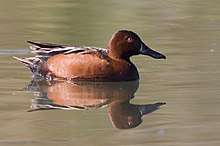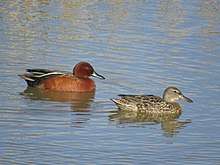Cinnamon teal
The cinnamon teal (Spatula cyanoptera) is a species of duck found in western North and South America. It is a small dabbling duck, with bright reddish plumage on the male and duller brown plumage on the female. It lives in marshes and ponds, and feeds mostly on plants.
| Cinnamon teal | |
|---|---|
 | |
| Spatula cyanoptera septentrionalium drake (male) | |
| Scientific classification | |
| Kingdom: | Animalia |
| Phylum: | Chordata |
| Class: | Aves |
| Order: | Anseriformes |
| Family: | Anatidae |
| Genus: | Spatula |
| Species: | S. cyanoptera |
| Binomial name | |
| Spatula cyanoptera (Vieillot, 1816) | |
| Subspecies | |
|
4 living, 1 possibly extinct; see text | |
 | |
| Synonyms | |
|
Anas cyanoptera Vieillot, 1816 | |
Description


The adult male has a cinnamon-red head and body with a brown back, a red eye and a dark bill. The adult female has a mottled brown body, a pale brown head, brown eyes and a grey bill and is very similar in appearance to a female blue-winged teal; however its overall color is richer, the lores, eye line, and eye ring are less distinct. Its bill is longer and more spatulate. Male juvenile resembles a female cinnamon or blue-winged teal but their eyes are red.[2][3] They are 16 in (41 cm) long, have a 22-inch (560 mm) wingspan, and weigh 14 oz (400 g).[3] They have 2 adult molts per year and a third molt in their first year.[3]
Distribution
Their breeding habitat is marshes and ponds in western United States and extreme southwestern Canada, and are rare visitors to the east coast of the United States.[3] Cinnamon teal generally select new mates each year. They are migratory and most winter in northern South America and the Caribbean,[4] generally not migrating as far as the blue-winged teal. Some winter in California and southwestern Arizona.[2] Two subspecies of cinnamon teal reside within the Andes of South America. The smaller sized S. c. cyanoptera is widespread within low elevations (<1000m) such as the coast of Peru and southern Argentina, whereas the larger size subspecies S. c. orinomus occupies elevations of 3500-4600 meters in the central Andes. [5]
Behavior

These birds feed by dabbling. They mainly eat plants; their diet may include molluscs and aquatic insects.
Taxonomy
They are known to interbreed with blue-winged teals,[2] which are very close relatives.
Subspecies are:
- Spatula cyanoptera septentrionalium (Oberholser, 1906) northern cinnamon teal breeds from British Columbia to northwestern New Mexico, and they winter in northwestern South America.[6]
- Spatula cyanoptera tropica (Snyder & Lumsden, 1951) tropical cinnamon teal occurs in the Cauca Valley and Magdalena Valley in Colombia.[6]
- Spatula cyanoptera borreroi (Snyder & Lumsden, 1951) Borrero's cinnamon teal (possibly extinct) occurs in the eastern Andes of Colombia with records of apparently resident birds from northern Ecuador.[6] It is named for Colombian ornithologist José Ignacio Borrero.
- Spatula cyanoptera orinoma (Snyder & Lumsden, 1951) Andean cinnamon teal occurs in the Altiplano of Peru, northern Chile and Bolivia.[6]
- Spatula cyanoptera cyanoptera (Vieillot, 1816) Argentine cinnamon teal occurs in southern Peru, southern Brazil, Argentina, Chile, and the Falkland Islands.[6]
References
- BirdLife International (2012). "Spatula cyanoptera". IUCN Red List of Threatened Species. 2012. Retrieved 26 November 2013.CS1 maint: ref=harv (link)
- Dunn, J (2006)
- Floyd T (2008)
- Herrera et al. (2006)
- Wilson, Robert E.; Peters, Jeffrey L.; McCracken, Kevin G. (2012-08-10). "GENETIC AND PHENOTYPIC DIVERGENCE BETWEEN LOW- AND HIGH-ALTITUDE POPULATIONS OF TWO RECENTLY DIVERGED CINNAMON TEAL SUBSPECIES". Evolution. 67 (1): 170–184. doi:10.1111/j.1558-5646.2012.01740.x. ISSN 0014-3820. PMID 23289570.
- Clements, J (2007)
Works cited
- Clements, James, (2007) The Clements Checklist of the Birds of the World, Cornell University Press, Ithaca
- Dunn, J. & Alderfer, J. (2006) National Geographic Field Guide to the Birds of North America 5th Ed.
- Floyd, T (2008) Smithsonian Field Guide to the Birds of North America Harper Collins, NY
- Herrera, Néstor; Rivera, Roberto; Ibarra Portillo, Ricardo & Rodríguez, Wilfredo (2006): Nuevos registros para la avifauna de El Salvador. ["New records for the avifauna of El Salvador"]. Boletín de la Sociedad Antioqueña de Ornitología 16(2): 1-19. [Spanish with English abstract]PDF fulltext
External links
| Wikimedia Commons has media related to Spatula cyanoptera. |
| Wikispecies has information related to Anas cyanoptera |
- "Cinnamon Teal media". Internet Bird Collection.
- Cinnamon Teal, Birds of North America Online
- Cinnamon Teal Species Account – Cornell Lab of Ornithology
- Cinnamon Teal photo gallery at VIREO (Drexel University)
- Interactive range map of Anas cyanoptera at IUCN Red List maps
